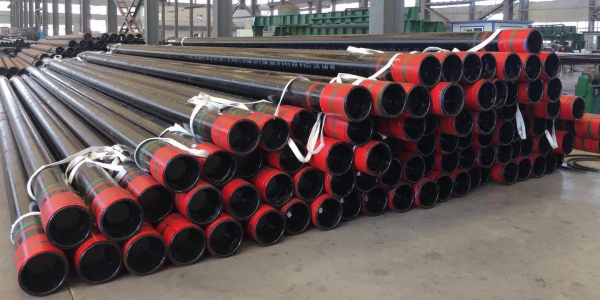Oil well pipes are widely used in the oil and gas industry, and quality defects can have a serious impact on project completion. Today, we will discuss oil well pipe quality defects and prevention in detail.

Quality Defects Of Oil Well Pipes:
The quality defects of oil well pipes mainly come from three aspects:
- Quality defects in the oil well pipe body itself
- Quality defects caused during the processing of oil well pipes
- Performance of oil well pipes (anti-extrusion performance, corrosion resistance, perforation performance, anti-jamming performance, etc.)
Oil Well Pipe Quality Defect Prevention:
During the processing of oil well pipes, the threads may have quality defects such as black buckles, thread deviations, broken threads, thread bumps (bumps), and thread parameters. The details are as follows:
(1) Threaded Black Leather Buckle
The threaded black leather buckle shows that the local processing amount of the threaded buckle is too small and appears "unsmooth", which is related to the outer diameter and wall thickness accuracy, ovality and straightness of the steel pipe end. The appearance of black leather buckles on the pipe body is often caused by the small outer diameter of the pipe, the pipe end is not straight enough, or the ellipse is too large. The black leather buckle of the coupling is generally caused by the outer diameter of the steel pipe being too large or the pipe wall being too negative or the ovality being too large.
(2) Threaded side wall
The deviated wall of the threaded buckle means that after the steel pipe is threaded, the wall thickness on one side is uneven and the other side is thicker. The reason for the deviation of the thread wall is similar to that of the threaded black leather buckle. It is caused by uneven wall thickness, bending or excessive ellipse at the end of the steel pipe. Sometimes when the thread processing is biased or the processing volume control is unreasonable, the thickness tolerance of the bottom wall of the thread may be too large, seriously affecting the connection strength of the oil well pipe.
(3) Disconnection
When the thread comb cuts the thread at high speed and force, once the thread end collapses and "falls off", it will cause thread breakage. usually. Broken buckles are mainly caused by large non-metallic inclusions in the steel, and are also related to the quality of the wire comb and the stability of the threading process.
(4) Thread damage
Oil well pipe thread damage includes bumps and scratches. It is generated during the production, transportation and storage of finished products. In order to prevent the exposed threads of the oil well pipe from being bumped, crushed, and rusted, in addition to ensuring that the threads do not collide with hard objects (such as conveying rollers, tilted grates, etc.), tighten the outer protective ring body threads with internal threads. The inner protective ring with external thread is screwed onto the coupling thread.
(5) Thread parameters exceed standards
Thread processing is the most important process in the production of oil well pipes, and it is also a key process that determines the thread quality of oil well pipes. At present, most oil well pipe thread processing uses special CNC machine tools. When processing threads, the workpiece is automatically centered and floating clamped. The thread processing tools use carbide tools, and the spindle speed is continuously variable.
Various parameters of the thread (pitch diameter, thread height, taper, pitch, thread angle, close pitch, etc.) will affect the connection strength and sealing performance of the thread. Thread tightness is the comprehensive value of the fluctuations of individual parameters of the thread. Even if individual parameters of the thread are qualified, the tight pitch may not be qualified.
The accuracy of various thread parameters is not only related to the quality of the tube blank. It is also related to the thread processing method, the type of machine tool and the stability of the processing process, as well as the dimensional accuracy and wear resistance of the thread comb. All other things being equal, the dimensional accuracy of the wire comb determines the accuracy of the wire size. Generally, the dimensional tolerance of thread combs is required to be only 1/3 to 1/4 of the product tolerance, or even higher.
(6) Torque and J value exceed the standard
Oil casing torque refers to the make-up torque generated when the coupling and pipe body are tightened. The purpose of controlling the torque is to ensure the connection strength between the coupling and the pipe body and the contact pressure stress on the thread side is large enough, and to use the corresponding thread sealant to prevent oil and casing leakage. For API standard threads, the J value represents the distance from the pipe end to the center of the coupling after tightening the coupling and the pipe body. It is one of the important parameters that determines the quality of the threaded connection.
(7) Leakage
To avoid leakage caused by insufficient contact pressure between the oil and casing oil, the casing body and the coupling thread, the oil and casing with couplings shall be subjected to hydrostatic tests according to standards. Leakage in the threads connecting the pipe body and coupling is related to factors such as thread type and quality, oil, casing tightening, and thread sealant quality. In terms of buckle type, the sealing performance of round threads is better than that of trapezoidal threads, and special threads are better. High-precision thread shape and reasonable oil and casing tightening torque are beneficial to improving the sealing performance of the thread. Thread sealant lubricates and fills thread gaps (seals).

 English
English Español
Español




 Tel : +86-18565811709
Tel : +86-18565811709 Email :
Email : 

 News
News




